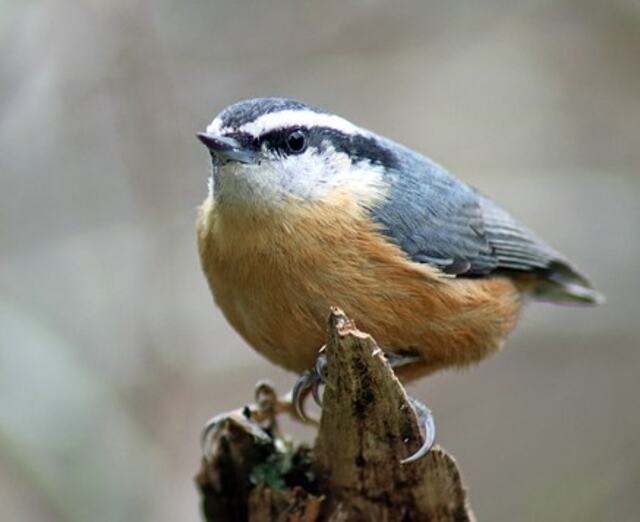Welcome to this article where we delve into the world of blue birds with striking orange chests. We’ll cover the different species, where they live, how they behave, and what’s being done to protect them. We’ll also share tips and photos to help you spot and appreciate these birds in nature.
Table of Contents
- 1 Blue Birds with Orange Chests
- 2 Common Mistakes to Avoid When Identifying Bird Colors
- 3 The Complexity of Identifying Blue in Birds
- 4 Adjusting to Different Lighting Conditions
- 5 Understanding Differences in Coloration by Sex and Age
- 6 Seasonal Changes in Plumage
- 7 Maximizing Camera and Monitor Settings
- 8 Geographic Distribution and Habitat Preferences
- 9 Mating and Breeding Behaviors
- 10 Conservation Status and Threats to Survival
- 11 Blue Bird with Orange Chest Meaning
- 12 Attracting Blue Birds with Orange Chests to Your Yard
- 13 Frequently Asked Questions
- 13.1 What blue bird has a red and white chest?
- 13.2 What is the blue bird that looks like a robin?
- 13.3 What is the difference between the Western Bluebird and the Eastern Bluebird?
- 13.4 What bird has a blue head and chest?
- 13.5 What is the name of the orange and blue bird?
- 13.6 What does it mean when a blue bird visits you?
- 13.7 What does a blue jay look like?
- 13.8 What is the rarest blue bird?
- 13.9 Why are Eastern bluebirds good to have around your property?
- 13.10 What is a common fairy bluebird?
- 13.11 Where do Western bluebirds go in the summer?
- 13.12 What bird has a blue and yellow chest?
- 13.13 What does a female blue jay look like?
- 13.14 Who are the bluebirds in Canada?
- 13.15 What’s the difference between blue birds and blue jays?
- 13.16 Is Blue bird a good omen?
- 13.17 What is the most common blue bird?
- 13.18 What is the number 1 rarest bird in the world?
- 13.19 What is the prettiest blue bird?
- 14 Conclusion
- 15 Author
Blue Birds with Orange Chests
Eastern Bluebird
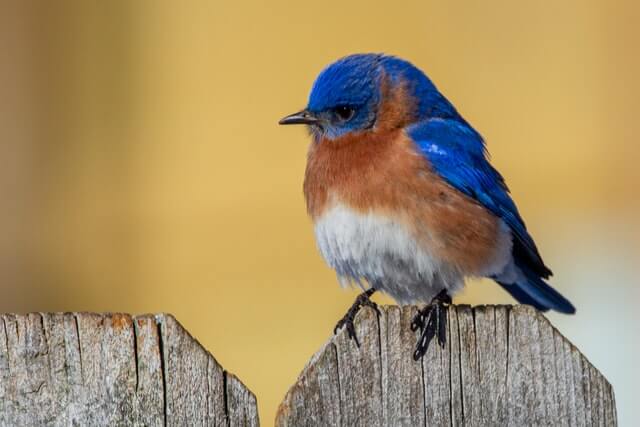
The Eastern Bluebird, also known as Sialia sialis, is a small and beautifully colored songbird that can be found in eastern North America. They typically measure around 6.3 to 8.3 inches in length, with a wingspan of 9.8 to 12.2 inches, and weigh between 0.74 to 1.02 ounces. The males have bright blue plumage on their backs, wings, and tail, with a rusty-red breast and white belly, while females have a more subdued blue-gray color with the same rusty-red breast and white belly.
Eastern Bluebirds can be found in a variety of habitats, including open woodlands, farmlands, and suburban areas. They feed mainly on insects during the breeding season, but will also consume fruits and berries during the winter months. Eastern Bluebirds are cavity nesters, preferring to build their nests in tree cavities or nest boxes. Their range extends from southern Canada to the Gulf of Mexico, and from the Atlantic coast to the Great Plains.
| Scientific Name | Bird Size | Weight | Wingspan | Habitat | Diet | Lifespan | Migratory |
|---|---|---|---|---|---|---|---|
| Sialia sialis | 6.5-8 inches | 0.9-1.1 oz | 10-12 inches | Open woodlands, fields, orchards | Insects, fruits, berries | 6-10 years | Yes, some populations migrate south in winter |
Western Bluebird

The Western Bluebird is a small thrush species, measuring around 16 to 18 centimeters in length and weighing around 30 grams. The male birds have a bright blue back, head, and wings, while the females have a gray-blue coloration. Both genders have a rusty-orange chest and white belly. The birds are known for their gentle and playful behavior, often perching on fence posts and branches, and fluttering their wings.
The Western Bluebird is found in the western regions of North America, including parts of California, Oregon, and Washington. They prefer open woodland areas with tall trees, and often nest in tree cavities or nest boxes. Their diet consists of insects, fruits, and berries, and they are known to catch insects while in flight. Despite being a fairly common species, their populations have been impacted by habitat loss and competition with non-native species.
| Scientific Name | Bird Size | Weight | Wingspan | Habitat | Diet | Lifespan | Migratory |
|---|---|---|---|---|---|---|---|
| Sialia mexicana | 6.25-7.5 inches | 0.8-1.1 oz | 12-15 inches | Wooded areas, forest edges, open habitats | Insects, spiders, fruits, berries | 6-10 years | Yes, some populations migrate south in winter |
Barn Swallow

The Barn Swallow is a medium-sized bird that is approximately 6.7-7.5 inches long with a wingspan of 12–13 inches. This bird is known for its beautiful blue and rusty-red coloration, with a blue-black head, a rusty-red throat, and a cream-colored belly. Barn Swallows are easily recognizable due to their long forked tails, which are a distinguishing feature of the species. Barn Swallows are widely distributed around the world, with breeding populations found in North America, Europe, and Asia.
These birds prefer open habitats such as fields, meadows, and wetlands, where they can find an abundance of insects to feed on. Their diet primarily consists of insects, which they catch in mid-air using their quick and agile flight skills. The Barn Swallow is an important species for pest control, as they eat a variety of insects including flies, mosquitoes, and beetles.
| Scientific Name | Bird Size | Weight | Wingspan | Habitat | Diet | Lifespan | Migratory |
|---|---|---|---|---|---|---|---|
| Hirundo rustica | 5.5-7.5 inches | 0.6-0.7 oz | 12-13 inches | Open habitats, often near water | Insects, mostly caught in flight | 4-6 years | Yes, migrates long distances between breeding and wintering grounds |
Red-breasted Nuthatch
The Red-breasted Nuthatch (Sitta canadensis) is a small, colorful bird that measures only 4.5 inches in length. It has a blue-gray back, a white face with a black eye stripe, and a distinctive rusty-red breast. This bird’s head is relatively large, with a long, narrow bill that curves downward. The Red-breasted Nuthatch is native to North America and can be found in coniferous forests across the continent.
It has adapted well to living in trees and has a unique ability to climb up and down trunks and branches with ease. Its diet consists mainly of insects, spiders, and seeds, which it gleans from the bark of trees. During the winter months, it will also visit bird feeders for a source of food. In general, the Red-breasted Nuthatch is an intriguing and attractive bird species that is highly admired by birdwatchers and individuals who have a passion for nature.
| Scientific Name | Bird Size | Weight | Wingspan | Habitat | Diet | Lifespan | Migratory |
|---|---|---|---|---|---|---|---|
| Sitta canadensis | 4.5-5 inches | 0.3-0.4 oz | 7-8 inches | Coniferous forests, mixed woods | Seeds, insects, spiders | 2-6 years | Yes, some populations migrate south in winter |
Lazuli Bunting
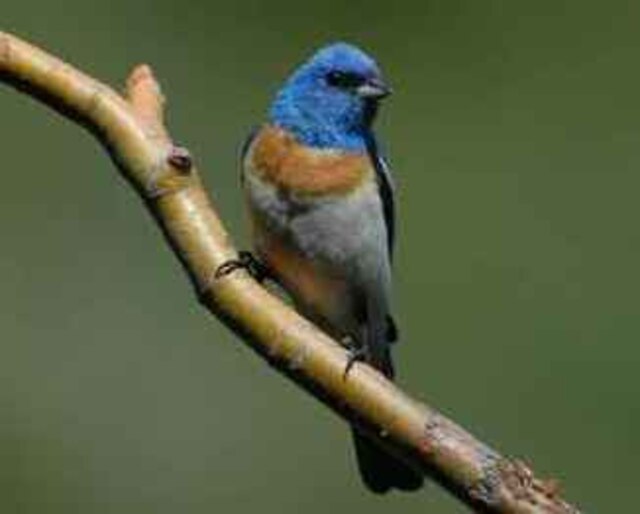
The Lazuli Bunting is a small passerine bird that measures around 12.5 cm in length and weighs between 9 and 12 grams. It has a striking appearance, with a bright blue head and back, a rusty orange breast, and white belly. The male’s coloring is more vibrant than the female’s, which is mostly brown with blue and rust-colored accents. One of its notable characteristics is its sweet and melodic song that can often be heard during its breeding season.
The Lazuli Bunting is native to North America, with a range that extends from southern Alaska to central Mexico. It is a common sight in brushy areas, woodland edges, and riparian habitats, where it feeds on insects, seeds, and berries. During migration, it can also be found in grasslands and agricultural fields. Despite its small size, the Lazuli Bunting is a beloved bird among birdwatchers and nature enthusiasts due to its stunning appearance and cheerful song.
| Scientific Name | Bird Size | Weight | Wingspan | Habitat | Diet | Lifespan | Migratory |
|---|---|---|---|---|---|---|---|
| Passerina amoena | 4.5-5 inches | 0.4-0.5 oz | 7-9 inches | Open habitats, often near water | Seeds, insects, spiders | 2-6 years | Yes, migrates south to Mexico and Central America in winter |
Common Kingfisher
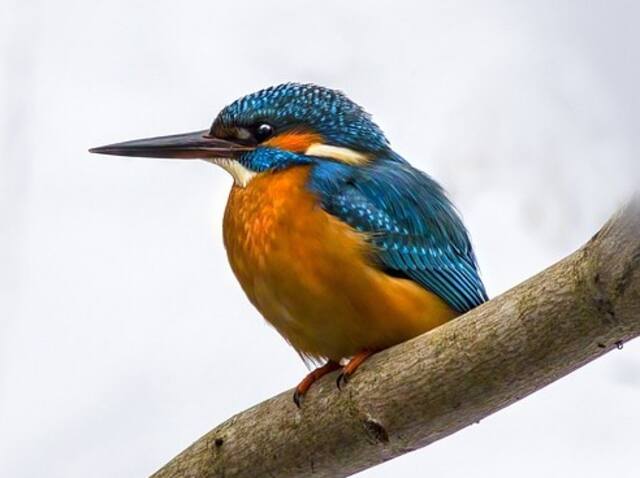
The Common Kingfisher is a small but striking bird with a distinctive blue and orange coloration. They measure between 4.3 to 5.1 inches in length and weigh only 0.4 to 0.5 ounces, making them one of the smallest kingfisher species. Their bright blue upperparts, orange underparts, and white throat make them easy to identify. Kingfishers are known for their remarkable diving and hunting abilities.
The Common Kingfisher is no exception, using its long, pointed beak to spear fish and aquatic invertebrates like dragonfly nymphs. They are found across Europe, Asia, and parts of North Africa, typically in freshwater habitats like rivers, streams, and lakes with suitable perches and fish populations. Despite being a relatively common species, their populations can be impacted by habitat degradation and pollution.
| Scientific Name | Bird Size | Weight | Wingspan | Habitat | Diet | Lifespan | Migratory |
|---|---|---|---|---|---|---|---|
| Alcedo atthis | 4.3 – 5.1 in | 0.4 – 0.5 oz | 7.9 – 9.8 in | Rivers, streams, and other bodies of freshwater with suitable perches and fish populations | Small fish, aquatic insects, and crustaceans | Up to 8 years | Some populations migrate south in winter, but many are resident year-round |
Varied Thrush
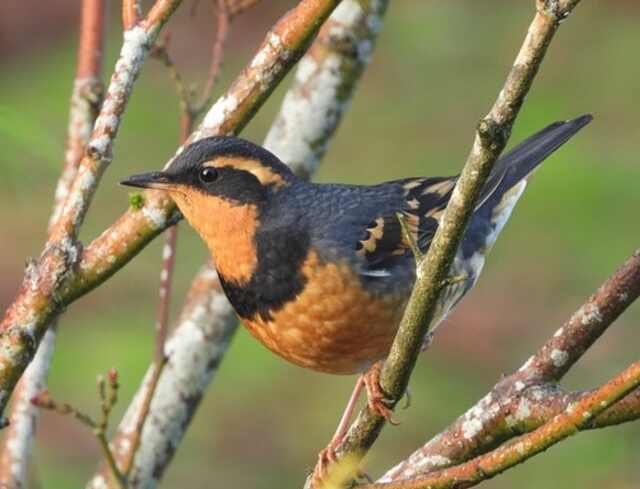
The Varied Thrush is a medium-sized songbird found in the western parts of North America. It is around 8–10 inches in length with a wingspan of about 13–15 inches. The male has striking orange-yellow markings on its face and underparts, while the female has a more muted brown coloration. This bird has a distinctive black stripe running across its eye, giving it a masked appearance.
Varied Thrushes are mainly found in coniferous forests, especially in the Pacific Northwest region of the US and Canada. They are known for their clear, whistled song, which can be heard throughout the forest during mating season. The Varied Thrush’s diet primarily includes insects, as well as berries and seeds. They often forage on the ground, using their strong legs and bill to search for food among leaf litter and fallen twigs.
| Scientific Name | Bird Size | Weight | Wingspan | Habitat | Diet | Lifespan | Migratory |
|---|---|---|---|---|---|---|---|
| Ixoreus naevius | 8.7 – 9.8 in | 2.0 – 2.9 oz | 14.6 in | Forested areas, particularly those with conifers | Insects, berries, and seeds | Up to 9 years | Some populations migrate south in winter |
Tickell’s Blue Flycatcher
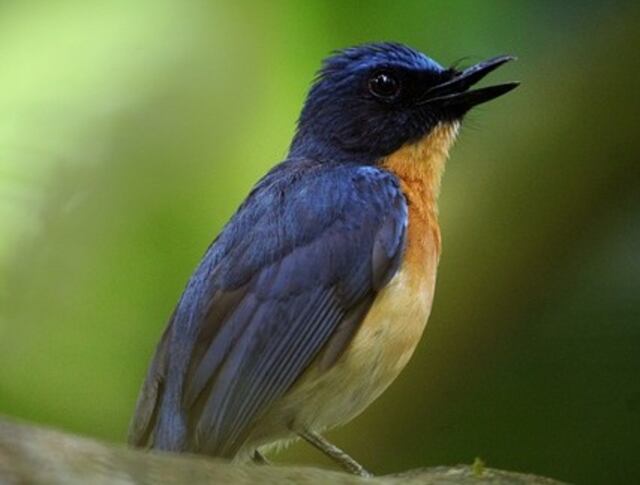
The Tickell’s Blue Flycatcher, also known as the White-browed Blue Flycatcher, is a small passerine bird native to the Indian subcontinent and Southeast Asia. The male has a vibrant blue plumage on its back and wings, with a distinctive white eyebrow and a black mask around the eyes. The female has a duller blue-gray plumage with a less prominent white eyebrow. The Tickell’s Blue Flycatcher is about 11 to 12 centimeters in length and weighs around 9 to 12 grams.
They can be found in a variety of habitats including forests, scrublands, and gardens. They primarily feed on insects, such as flies, moths, and grasshoppers. The Tickell’s Blue Flycatcher is a migratory bird and its breeding range extends from the Himalayan foothills to central India and Southeast Asia. It is a delightful bird to observe, with its vivid blue plumage and its acrobatic flights while foraging for food.
| Scientific Name | Bird Size | Weight | Wingspan | Habitat | Diet | Lifespan | Migratory |
|---|---|---|---|---|---|---|---|
| Cyornis tickelliae | 4.3 in | 0.25 oz | 6.7 in | Forests, woodlands, and gardens in parts of Asia | Insects, spiders, and other small invertebrates | Up to 5 years | Some populations migrate south in winter |
Common Mistakes to Avoid When Identifying Bird Colors
When it comes to identifying bird colors, there are some common mistakes that even experienced birders can make. Here are some pitfalls to avoid when identifying blue birds with orange chests:
- Relying too heavily on color: The color of a bird can be influenced by a variety of factors, such as lighting conditions, time of day, and age of the bird. Therefore, it’s important to also consider other identification markers such as shape, size, and behavior.
- Overgeneralizing: Not all birds with blue feathers and an orange chest are the same species. It’s important to look closely at other identifying features, such as the shape and size of the beak, eye markings, and wing patterns, to accurately identify the species.
- Ignoring sex and age differences: Male and female birds may have different coloration, and juveniles may have different plumage than adults. Make sure to take these factors into consideration when identifying blue birds with orange chests.
- Neglecting seasonal variation: Some bird species may have different plumage during breeding season versus non-breeding season. Make sure to consult a field guide or other reliable source to identify any seasonal differences in plumage.
| Common Mistake | Tips to Avoid |
|---|---|
| Misjudging lighting conditions | Try to observe birds in different lighting conditions and from different angles. Consider how the light may affect the bird’s coloration. |
| Not accounting for sex and age differences | Research the specific species and learn how to differentiate between males, females, and juveniles. |
| Failing to consider seasonal variation | Be aware of how the bird’s plumage may change throughout the year. |
| Over-reliance on photographs | Remember that photographs can be misleading and may not accurately represent the bird’s true colors. Observe birds in person when possible. |
The Complexity of Identifying Blue in Birds
Identifying blue hues in birds can be challenging due to the complexity of the color and the variability of the lighting conditions. Different shades of blue can appear similar or even change depending on the lighting, leading to confusion in identification.
To help with distinguishing different shades of blue, here are some tips:
- Look for patterns or markings on the bird’s body that can help with identification.
- Observe the bird in different lighting conditions, such as direct sunlight or shade.
- Use binoculars or a spotting scope to get a better view of the bird’s coloring and details.
Table: Tips for Distinguishing Different Shades of Blue in Birds
| Tip | Description |
|---|---|
| Look for patterns or markings | Identify unique patterns or markings on the bird’s body |
| Observe in different lighting | Observe the bird in different lighting conditions |
| Use binoculars or scope | Get a better view of the bird’s coloring and details |
Adjusting to Different Lighting Conditions
When it comes to observing bird colors, lighting conditions can greatly affect how the colors appear. Here are some techniques for dealing with glare or shadow when observing blue birds with orange chests:
- Avoiding direct sunlight: Direct sunlight can wash out colors and create glare, making it difficult to accurately identify the bird’s colors. Try to position yourself so that the sun is behind you or wait for a cloud to pass overhead.
- Using shade: Shade can help to reduce glare and provide better lighting conditions for observing bird colors. Look for a shaded area or create your own shade using an umbrella or other shade device.
- Adjusting your angle: Changing your angle or position in relation to the bird can help to reduce glare or shadow and provide a better view of the bird’s colors. Try moving to a different location or adjusting your height to find the best angle.
Table:
| Lighting Conditions | Techniques |
|---|---|
| Direct sunlight | Position yourself so that the sun is behind you or wait for a cloud to pass overhead |
| Shade | Look for a shaded area or create your own shade using an umbrella or other shade device |
| Glare or Shadow | Change your angle or position in relation to the bird to reduce glare or shadow |
Understanding Differences in Coloration by Sex and Age
In many species of birds, there are noticeable differences in coloration between males and females, as well as between adults and juveniles. It is important to be able to identify these differences in order to correctly identify the species.
One common difference in coloration is that males may have brighter or more vibrant colors than females, particularly on the chest or belly. In some species, females may have more subdued or even completely different coloration.
Age can also play a role in coloration. Juveniles may have duller or less defined colors compared to adults. In some species, juveniles may have entirely different coloration than adults until they reach maturity.
To identify these differences, it is important to observe the bird carefully and compare it to descriptions or images of both sexes and all age ranges of the species. Pay attention to the color and pattern of the chest, belly, and other areas where there may be noticeable differences.
Table:
| Sex/Age | Coloration |
|---|---|
| Male | Brighter or more vibrant colors, particularly on the chest or belly |
| Female | More subdued or even completely different coloration in some species |
| Juvenile | Duller or less defined colors, and may have entirely different coloration than adults until they reach maturity |
Seasonal Changes in Plumage
Seasonal changes in plumage can have a significant impact on the coloration of blue birds with orange chests. During breeding season, males often display brighter and more vibrant colors to attract a mate, while females tend to have more subdued colors for camouflage purposes. Outside of breeding season, both males and females may exhibit a more drab coloration.
It is important to note that not all species of blue birds with orange chests undergo significant seasonal changes in plumage. For example, the Blue Grosbeak maintains its bright blue and rusty-orange plumage year-round. However, species such as the Eastern Bluebird and Mountain Bluebird may exhibit variations in coloration depending on the time of year.
Breeding plumage is typically the brightest and most distinct plumage that a bird displays, while non-breeding plumage may be less vibrant and more similar between males and females. By understanding these seasonal changes, birders can more accurately identify blue birds with orange chests and appreciate the unique beauty that each season brings.
Table: Examples of Blue Birds with Orange Chests and Seasonal Changes in Plumage
| Blue Birds with Orange Chests | Breeding Plumage | Non-breeding Plumage |
|---|---|---|
| Eastern Bluebird | Bright orange | Duller orange |
| Western Bluebird | Bright orange | Duller orange |
| Barn Swallow | Rusty-orange | White underparts |
| Red-breasted Nuthatch | Rusty-orange | Duller orange |
| Lazuli Bunting | Bright blue | Duller blue |
| Belted Kingfisher | Rusty-orange | White underparts |
| Varied Thrush | Bright orange | Duller orange |
| Tickell’s Blue Flycatcher | Bright blue | Duller blue |
Maximizing Camera and Monitor Settings
Capturing and displaying bird colors accurately can be challenging, but optimizing camera and monitor settings can greatly improve the quality of your photos. Below are some tips to help you achieve optimal results:
- Adjust white balance: Use the white balance feature on your camera to adjust for different lighting conditions and achieve more accurate colors.
- Use a polarizing filter: A polarizing filter can help reduce glare and increase contrast, leading to better color representation.
- Increase saturation: Increasing the saturation setting on your camera or during post-processing can help bring out the vibrancy of colors.
- Use a calibrated monitor: Calibrating your monitor ensures that the colors you see on the screen are accurate and consistent.
- Avoid compression: High compression settings can result in loss of color information, so try to use the highest quality settings possible when saving your photos.
Table: Camera and Monitor Settings Optimization
| Setting | Tips |
|---|---|
| White Balance | Adjust for different lighting conditions |
| Polarizing Filter | Reduce glare and increase contrast |
| Saturation | Increase to bring out vibrancy |
| Monitor Calibration | Ensure accuracy and consistency |
| Compression | Avoid high compression settings |
By implementing these tips and utilizing the table above, you can enhance the quality of your bird photos and showcase the beautiful blue birds with orange chests in their true colors.
Geographic Distribution and Habitat Preferences
Blue birds with orange chests can be found in different regions of the world, including North America, Central America, South America, and Asia. Some of the specific areas where these birds are commonly found include the western United States, Mexico, and parts of South America such as Colombia, Ecuador, and Brazil.
In terms of habitats and ecosystems, blue birds with orange chests are often found in forested areas with dense vegetation, such as tropical rainforests or deciduous forests. They may also be found in shrublands or grasslands, but these habitats are less common. Some species prefer to live in higher elevations, while others are found closer to sea level.
To summarize the geographic distribution and habitat preferences of blue birds with orange chests, refer to the table below:
| Species | Geographic Distribution | Preferred Habitats |
|---|---|---|
| Eastern Bluebird | Eastern and Central North America | Open woodlands, farmland, suburban areas |
| Western Bluebird | Western North America | Open woodlands, meadows, agricultural areas |
| Barn Swallow | Worldwide | Open habitats near water, including agricultural fields, wetlands, and urban areas |
| Red-breasted Nuthatch | Northern North America | Coniferous forests |
| Lazuli Bunting | Western North America | Shrublands, open woodlands, and riparian areas |
| Belted Kingfisher | North and Central America | Rivers, streams, lakes, and coastal areas |
| Varied Thrush | Western North America | Coniferous and mixed forests |
| Tickell’s Blue Flycatcher | South and Southeast Asia | Forests, including both tropical and subtropical regions |
Mating and Breeding Behaviors
Blue birds with orange chests have a variety of mating and breeding behaviors, depending on the species. Here are some examples:
- Eastern Bluebird: They are monogamous and form pairs during the breeding season. The male attracts the female by offering her food, and they build a nest together in a tree cavity or nest box. The female lays 3-7 eggs and incubates them for about two weeks.
- Western Bluebird: They also form monogamous pairs, and the male helps the female build the nest. They lay 4-6 eggs and incubate them for about two weeks. Both parents share chick care until fledging.
- Barn Swallow: They are also monogamous and often return to the same nesting site each year. They build their nests out of mud and grass, usually on a horizontal surface such as a beam or ledge. The female lays 3-7 eggs and incubates them for about two weeks.
- Red-breasted Nuthatch: They are monogamous and build their nests in tree cavities. The female lays 5-7 eggs and incubates them for about two weeks. Both parents share chick care until fledging.
- Lazuli Bunting: They form pairs during the breeding season, and the male performs a courtship display to attract the female. The female builds the nest, which is usually in a shrub or small tree. They lay 3-5 eggs and incubate them for about two weeks.
- Belted Kingfisher: They are also monogamous and build their nests in river banks or cliffs. The female lays 5-8 eggs and incubates them for about three weeks. Both parents share chick care until fledging.
- Varied Thrush: They are monogamous and build their nests in tree branches or stumps. The female lays 3-5 eggs and incubates them for about two weeks. Both parents share chick care until fledging.
- Tickell’s Blue Flycatcher: They form monogamous pairs and build their nests in tree hollows or crevices. The female lays 2-4 eggs and incubates them for about two weeks. Both parents share chick care until fledging.
Table:
| Species | Mating System | Nesting Site | Number of Eggs |
|---|---|---|---|
| Eastern Bluebird | Monogamous | Tree cavity or nest box | 3-7 |
| Western Bluebird | Monogamous | Tree cavity or nest box | 4-6 |
| Barn Swallow | Monogamous | Mud nest on a horizontal surface | 3-7 |
| Red-breasted Nuthatch | Monogamous | Tree cavity | 5-7 |
| Lazuli Bunting | Monogamous | Shrub or small tree | 3-5 |
| Belted Kingfisher | Monogamous | River banks or cliffs | 5-8 |
| Varied Thrush | Monogamous | Tree branches or stumps | 3-5 |
| Tickell’s Blue Flycatcher | Monogamous | Tree hollows or crevices | 2-4 |
Conservation Status and Threats to Survival
According to the International Union for Conservation of Nature (IUCN) Red List, the conservation status of blue birds with orange chests varies by species. The following table shows the conservation status of some species of blue birds with orange chests:
| Species | Conservation Status | Threats to Survival |
|---|---|---|
| Eastern Bluebird | Least Concern | Habitat loss, predation, nest competition, pesticides |
| Western Bluebird | Near Threatened | Habitat loss, competition for nest sites, climate change |
| Barn Swallow | Least Concern | Habitat loss, pesticide use, nest disturbance |
| Red-breasted Nuthatch | Least Concern | Habitat loss, competition for nest sites, climate change |
| Lazuli Bunting | Least Concern | Habitat loss, nest parasitism, climate change |
| Belted Kingfisher | Least Concern | Habitat loss, water pollution, nest disturbance |
| Varied Thrush | Least Concern | Habitat loss, climate change, predation |
| Tickell’s Blue Flycatcher | Least Concern | Habitat loss, competition for nest sites, climate change |
Conservation efforts for these birds include habitat conservation, nest box programs, and reducing pesticide use. However, ongoing threats such as climate change and habitat loss continue to affect their populations.
Blue Bird with Orange Chest Meaning
Blue birds with orange chests can have different meanings depending on the cultural and symbolic context. In some cultures, blue birds with orange chests are considered symbols of happiness, joy, and optimism.
They are believed to bring positive energy and good fortune to those who encounter them. In other contexts, blue birds with orange chests can represent courage, confidence, and strength. They are seen as powerful and determined creatures that can overcome challenges and obstacles.
In addition to cultural and symbolic meanings, blue birds with orange chests also have ecological and biological significance. These birds are often found in specific habitats and play important roles in their ecosystems, such as pollination, seed dispersal, and insect control.
Understanding the ecological significance of blue birds with orange chests can help us appreciate the interconnectedness of all living things and the importance of biodiversity conservation.
Attracting Blue Birds with Orange Chests to Your Yard
If you want to attract blue birds with orange chests to your backyard, there are several things you can do:
- Provide food: Blue birds with orange chests are attracted to a variety of foods, such as mealworms, suet, and sunflower seeds.
- Install a birdbath: Providing a source of water can help attract blue birds with orange chests to your yard. Make sure to clean and refill the birdbath regularly.
- Plant native plants: Blue birds with orange chests are attracted to native plants that provide shelter and food, such as berry bushes and wildflowers.
- Install nesting boxes: Blue birds with orange chests may use nesting boxes to raise their young. Make sure to place the boxes in a suitable location and monitor them regularly.
Table:
| Bird Species | Preferred Food | Preferred Habitat |
|---|---|---|
| Eastern Bluebird | Mealworms, fruit, insects | Open woodland, fields |
| Western Bluebird | Berries, insects, seeds | Open woodland, sagebrush |
| Barn Swallow | Insects, spiders | Fields, barns, bridges |
| Red-breasted Nuthatch | Seeds, insects | Coniferous forests |
| Lazuli Bunting | Seeds, insects | Brushy areas, open woods |
| Belted Kingfisher | Fish, crayfish | Rivers, streams |
| Varied Thrush | Insects, berries | Coniferous forests |
| Tickell’s Blue Flycatcher | Insects | Wooded areas, gardens |
Note: While all the listed bird species have some degree of blue and orange coloring, not all of them have blue feathers on their body and orange on their chest.
Frequently Asked Questions
What blue bird has a red and white chest?
The blue bird with a red and white chest is the male Eastern Bluebird. This species is known for its beautiful blue back, wings, and tail feathers, with a rusty-red breast and white belly.
What is the blue bird that looks like a robin?
The blue bird that looks like a robin is the Mountain Bluebird. It has a bright blue body with a slightly paler blue head and white underbelly.
What is the difference between the Western Bluebird and the Eastern Bluebird?
The Western Bluebird and the Eastern Bluebird have similar physical characteristics, but they have different ranges and habitats. The Western Bluebird is typically located in the western region of North America, while the Eastern Bluebird is predominantly found in the eastern region of the continent.
What bird has a blue head and chest?
The Blue Jay has a blue head, chest, and back, with white and black markings on its wings and tail.
What is the name of the orange and blue bird?
The name of the orange and blue bird is the Blue-faced Parrot Finch.
What does it mean when a blue bird visits you?
In many cultures, blue birds are considered symbols of happiness, joy, and optimism. Seeing a blue bird can be a sign of good luck or a positive change in your life.
What does a blue jay look like?
Blue Jays have blue heads, backs, wings, and tails, with white underbellies and black markings on their wings and tail feathers. A unique feature of these birds is the crest of feathers on their heads.
What is the rarest blue bird?
The rarest blue bird is the Spix’s Macaw, which is critically endangered and may be extinct in the wild.
Why are Eastern bluebirds good to have around your property?
Eastern Bluebirds are beneficial to have around your property because they eat insects and other pests that can harm your plants and gardens. In addition, they assist in the pollination of flowers and the distribution of seeds.
What is a common fairy bluebird?
The Common Fairy Bluebird is a species of bird found in Southeast Asia. It has bright blue feathers and a long, curved beak.
Where do Western bluebirds go in the summer?
Western Bluebirds typically breed in the western United States and southwestern Canada during the summer months. Some populations may migrate to Mexico or the southern United States during the winter.
What bird has a blue and yellow chest?
The Prothonotary Warbler has a bright yellow-orange head and chest, with blue-gray wings and tail feathers.
What does a female blue jay look like?
Female Blue Jays have a similar appearance to males, but their blue feathers are often paler and grayer, and they may have less distinct markings on their wings and tail feathers.
Who are the bluebirds in Canada?
The Bluebirds in Canada refer to the Eastern Bluebird species, which can be found in the eastern part of North America, including parts of Canada.
What’s the difference between blue birds and blue jays?
Blue birds are a group of birds that can have different physical characteristics and include species such as Eastern Bluebirds and Mountain Bluebirds. Blue Jays, on the other hand, are a specific species of bird with blue feathers and a distinctive crest on their heads.
Is Blue bird a good omen?
Blue birds have long been regarded as symbols of happiness, joy, and optimism in various cultures around the world. Seeing a blue bird can be a positive omen or a sign of good things to come.
What is the most common blue bird?
Bluebird. They are found in the eastern part of the continent and are known for their vibrant blue color and rusty-red breast. They are often found in open fields, pastures, and along roadsides.
What is the number 1 rarest bird in the world?
The number one rarest bird in the world is the Madagascar pochard. This species is critically endangered and may be extinct in the wild.
What is the prettiest blue bird?
The answer to this question is subjective, as beauty is in the eye of the beholder. However, some of the most commonly cited beautiful blue birds include the Blue Jay, the Mountain Bluebird, and the Turquoise-browed Motmot.
Conclusion
In conclusion, blue birds with orange chests are some of the most beautiful and fascinating birds in the world. From the Eastern Bluebird to the Lazuli Bunting and the Tickell’s Blue Flycatcher, these birds exhibit a range of colors, behaviors, and habitats that are truly remarkable.
Whether you’re a bird enthusiast or just appreciate the natural beauty around you, take some time to learn more about these amazing birds and the important roles they play in our ecosystems. With a little patience and a lot of curiosity, you might just discover something new and inspiring about the world of blue birds with orange chests.
Related Post: 15 Best Blue Bird Art Pieces (That Will Make You Smile!)


